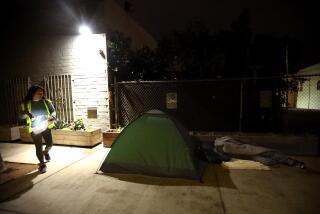A Break for O.C. Homeless
- Share via
A missing element in coping with problems of the homeless in Orange County has been community commitment, especially by the private sector. Why? Perhaps too many people doubt that homelessness can be a serious problem in so prosperous a county.
But homelessness is a serious problem, and it does need a community effort. A beginning impetus may have come last week when the county’s Building Industry Assn. started its HomeAid program.
What makes the program so noteworthy is not so much its scope--which is rather small--but that it marks the developers’ first major effort to direct resources from the private building industry to the homeless. HomeAid involves about $1 million and will add about 35 “transitional housing” beds throughout the county.
Modest as that may seem in contrast with the need to shelter 8,000 to 10,000 homeless people--half of them children--the developers’ program involves about four times as much money as homeless advocates get each year from the state.
To meet current needs, the county should have about 4,500 transitional beds--places for people and families to stay while they get on their feet. There are only about 200.
Emergency shelters are the first step away from homeless status. Transitional beds are the second, places to stay while accumulating advances and deposits needed to become renters. The last step is an adequate supply of affordable housing.
We welcome developers to the fight to get homeless people off the streets and back into permanent housing. We hope that the move will encourage other businesses and industries to help.
According to surveys, about 30% of the county’s homeless population come from the middle class; most have lived in the county for about 10 years and have high school educations or better. Illness, a lost job, divorce or other setbacks have made them homeless. Some work but cannot save the money for an apartment.
The BIA program will help some of those residents. It would help more if it touched off a public-private partnership to produce enough lower-cost housing to provide that third step away from homelessness: a permanent residence.
More to Read
Sign up for Essential California
The most important California stories and recommendations in your inbox every morning.
You may occasionally receive promotional content from the Los Angeles Times.






